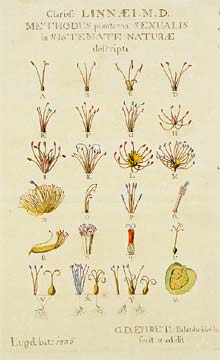Methodus Plantarum Sexualis – Linnaeus’s Sexual System
In the largest blocks of the Linnaeus Garden, Area perennis and Area annua, the plants are arranged according to the Sexual System, as in the time of Linnaeus.
The Sexual System was a simple and practical method of dividing the plant kingdom into groups, based on the arrangement of stamens and pistils. It had a huge impact when it was launched in Linnaeus’s book Systema Naturae in 1735.
The organising principles of the Sexual System are shown in the picture. In the text, Linnaeus describes the Sexual System in two ways: metaphorically in terms of weddings between men and women, and technically using botanical terminology. The number and arrangement of stamens assigns the plant to one of 24 different classes; each class is divided into orders, diagnosed by the number of pistils or styles in the flower.
The Sexual System is an artificial system of classification that yields non-natural groups, something that Linnaeus himself was well aware of. Closely related plants could end up in different groups simply because they happened to have different numbers of stamens. Today the Sexual System has been replaced by a modern approach to systematics, based on new methods and incorporating an evolutionary perspective on plant diversity. The aim is to identify natural groups of plants where all the members share a single common ancestor.
Overview of The sexual system (Swedish)

Linnes sexualsystem. Foto: Uppsala universitetsbibliotek
